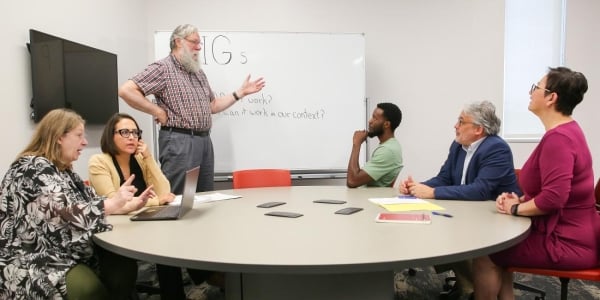Since 2015, Indiana University Northwest has hosted communities of practice for faculty members to evaluate and experiment with evidence-based pedagogies.
A university commitment to researching and understanding evidence-based interventions in the classroom has resulted in improvements to student success measures and fostered an innovative mindset among faculty members.
The Pedagogical Interest Groups (PIGs) at Indiana University Northwest in Gary, Ind., connect a small group of professors each semester to analyze and implement research-backed pedagogies in their classrooms.
Prior to the creation of PIGs, “IU Northwest did not have particularly good measures of student success,” says Mark Hoyert, dean of the College of Arts and Sciences, with low retention and graduation rates—particularly for students of color.
Over the past eight years, the university has seen improved GPAs, first- to second-year retention rates and overall completion, and was recently recognized by Excelencia in Education for improvements for Latino student success.
How it works: The title of “PIGs” came from the first community of practice, with group members placing special emphasis on having pedagogy and group in the name. “Once we got something that had an acronym, it stuck,” Hoyert says.
The PIGs meet around nine to 10 times a semester, operating similarly to a graduate seminar, Hoyert explains. One member presents data from one or several articles about a pedagogical practice, and then the group analyzes and critiques the research. Each group has six to eight people, and the groups are carefully curated by campus leaders.
“We try to have a blend of people who we think are easy sells or true believers, and then we always try to have at least one, if not two, but not more than two people who are very dubious of it from the very beginning,” Hoyert says. “That gives us an opportunity to have a conversation about … why are you doing this, what are your goals here?”
Hoyert tries to attend every PIG meeting, as well, demonstrating the university’s commitment to investing in faculty and student success.
With each pedagogical technique, faculty investigated the outcomes as outlined in the journal article and if it was something that could fit into their teaching style. “You can pick any of them, there’s a wide range of them and you can find ones that suit you; you can find ones that fit within your teaching skin,” Hoyert says.
One factor that group members take a hard look at is the rate of improvement from the intervention. The university didn’t want to see a two-percentage-point change, because that would be basically negligible in classes for 20 to 25 students.
Each instructor also committed to using at least one new intervention in their classes to try and replicate the results.
One practice that has produced great results is collaborative learning, decreasing DFW rates and increasing attendance among students in classes where the intervention is practiced. In one math course, instructors saw DFW rates invert after implementing collaborative learning, going from a course with one of the highest failure rates to a class with one of the best passing rates for first-year students, Hoyert says.
Other practices that have come from the PIGs include introducing a summer bridge program, offering first-year seminars and redesigning curricula in general.
The impact: Since launching the initiative, IU Northwest has seen increased retention, graduation and course success rates across all students but particularly among historically marginalized students.
First- to second-year retention grew 3.5 percentage points, from 64.6 percent in 2015 to 68.1 percent in 2022. Six-year graduation rates rose 16.4 percentage points, and the campuswide DFW rate dropped from 31.6 percent in 2015 to 25.6 percent in 2023.
For Latino students particularly, retention rose from 61.6 percent in 2015 to 75.8 percent in 2022, graduation climbed 17.2 points to 38.4 percent in six years and the median GPA among Latino students rose from 2.20 to 2.57 in 2023. The university grew from an emerging Hispanic-serving institution in 2015 to an HSI in 2020, as well, making it eligible for Title III and Title V grants.
One of the benefits of the PIGs is that it’s resource-free, requiring nothing more than faculty members’ commitment to engage. Since launching the program, IU Northwest has attracted additional funding, which has helped scale the program and allowed administrators to invest dollars into student success initiatives, but that’s all building on the efforts from PIG participants.
Members of the PIGs often challenge each other’s thinking and teaching in ways that produce positive results as well, Hoyert says: “The PIGs that had the most vocal of the curmudgeons work the best.”
Not everyone at IU Northwest is sold on the groups, but many freely volunteer to attend and want to continue joining them.
The university continues to monitor and evaluate use and implementation of the techniques identified within the PIGs to ensure each intervention is producing the desired results, which can require time and investment of resources to collect data.
Do you have an academic intervention that might help others improve student success? Tell us about it.

